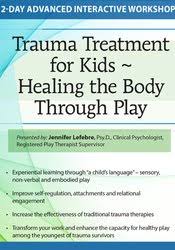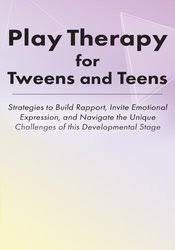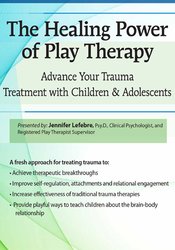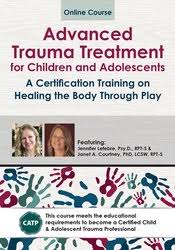🎁 Exclusive Discount Just for You!
Today only: Get 30% OFF this course. Use code MYDEAL30 at checkout. Don’t miss out!
Their trauma stays trapped in their body – they feel overwhelmed, they don’t sleep, they’re anxious, depressed, failing in school, angry and socially isolated.
Jennifer Lefebre – Trauma Treatment for Kids

- Neuroscience and Childhood Trauma Trauma Theory
- Fight-Or-Flight (parasympathetic/sympathetic nervous system)
- Attachment Theory
- Assessment
- Complex Trauma
- Post-Traumatic Stress Disorder
- Reactive attachment disorder
- Developmental Trauma Disorder
- A new conceptualization and integrated clinical framework
- Essential Components for Trauma-Informed Treatments
- Safety and competence/worth are established
- Appropriate attachments & relational engagement
- Self-regulation (body & emotions)
- Self-reflection & Introspection
- Integration of traumatic experiences (acknowledgment & processing of the trauma)
- Future safety: Transitioning beyond the Trauma
- Body Based Treatment Emotional and behavioral regulation
- Nonverbal and verbal responses: How to recognize trauma without a verbal report
- Bottom-Up versus Top-Down processing – Trauma starts in the body
- Traumatized children’s developmental needs
- Embodied play & sensory integration – emotional and behavioral regulation
- Integrating play therapy into evidence-Based Treatments
- These components “fit” the child’s specific needs
- TF-CBT- Trauma Focused Cognitive Behavioral Therapy
- Eye Movement Desensitization & Reprocessing – EMDR
- CPP – Child Parent Psychotherapy
- ARC – Attachment Regulation and Competency
- TARGET – Trauma Adaptive Recovery Group Education Therapy
- Play Therapy Principles
- Therapist establishes friendly relationship
- Accept the child as he/she is
- Allows child to express his/her opinions in a non-constrained manner
- Validates (acknowledge and reflect) child’s feelings
- Responsibilities for The child is the one who makes most of the decisions and changes.
- The therapeutic process is directed by the child; the therapist follows.
- It is important to take time for therapeutic interaction.
- Limits can only be set when absolutely necessary for child’s outcomes
- Advancing Trauma Treatment Play Therapy
- Non-verbal techniques
- Sensory-Based techniques
- Techniques that are culturally and developmentally appropriate
- Play Therapy Techniques and Strategies
- Integration of traumatic experiences to acknowledge and process the trauma: Sandtrays, drawings, & play
- Stop blaming yourself-doubt, and selfcompassion: Sandtray Safeplace & All About Me
- Get a better understanding of the brainbody relationship with Flip your lid.
- Target indiscriminate attachments and interpersonal reactivity: Invisible String & Family Sandtray
- Stressballs, Feelings Maps, Feelings Maps, Trashballs and Yoga can help you improve your emotional and physical regulation.
Would you like to be contacted? Jennifer Lefebre – Trauma Treatment for Kids ?
Description:
- Experiential learning is possible through “a child’s language” Sensory, non-sensual-Verbal and embodied plays
- Self-improvement-Regulation, attachments and relational involvement
- Traditional trauma therapies can be more effective
- Transform your work and increase your capacity for Healthy play among trauma survivors younger than 18 years old
Children are affected emotionally and psychologically by trauma.
Their trauma stays trapped in their body – they feel overwhelmed, they don’t sleep, they’re anxious, depressed, failing in school, angry and socially isolated.
They are totally vulnerable.
As a therapist, how do you get to the root cause of people’s pain? What do you do when words and language can’t be accessed, when conventional treatments aren’t enough?
Play is a child’s natural way to expose their trauma, formulate their narrative and begin to process the trauma.
Join trauma expert, Dr. Jennifer Lefebre Participate in this interactive, experiential workshop to learn how to communicate with traumatized children.
- Play therapy can be combined with trauma treatment to give children an engaging, developmentalally appropriate, and empirically supported treatment.
- You can combine essential components of trauma treatment with non-sensual, sensory components.-Verbal and embodied play can be used to address children’s interest and help you advance your work with them.
- Innovative and effective ways to improve one’s self-Regulation, attachments, relational engagement and regulation integrate traumatic experience and build competence and worth
- You can access a clinical framework that incorporates trauma theory, neuroscientific research, and play therapy principles.
- Increase your capacity for Healthy play among trauma survivors younger than 18 years old
Let us breathe new life into trauma treatment for kids!
Here’s what you’ll get in Jennifer Lefebre – Trauma Treatment for Kids

Course Features
- Lectures 1
- Quizzes 0
- Duration Lifetime access
- Skill level All levels
- Language English
- Students 0
- Assessments Yes



